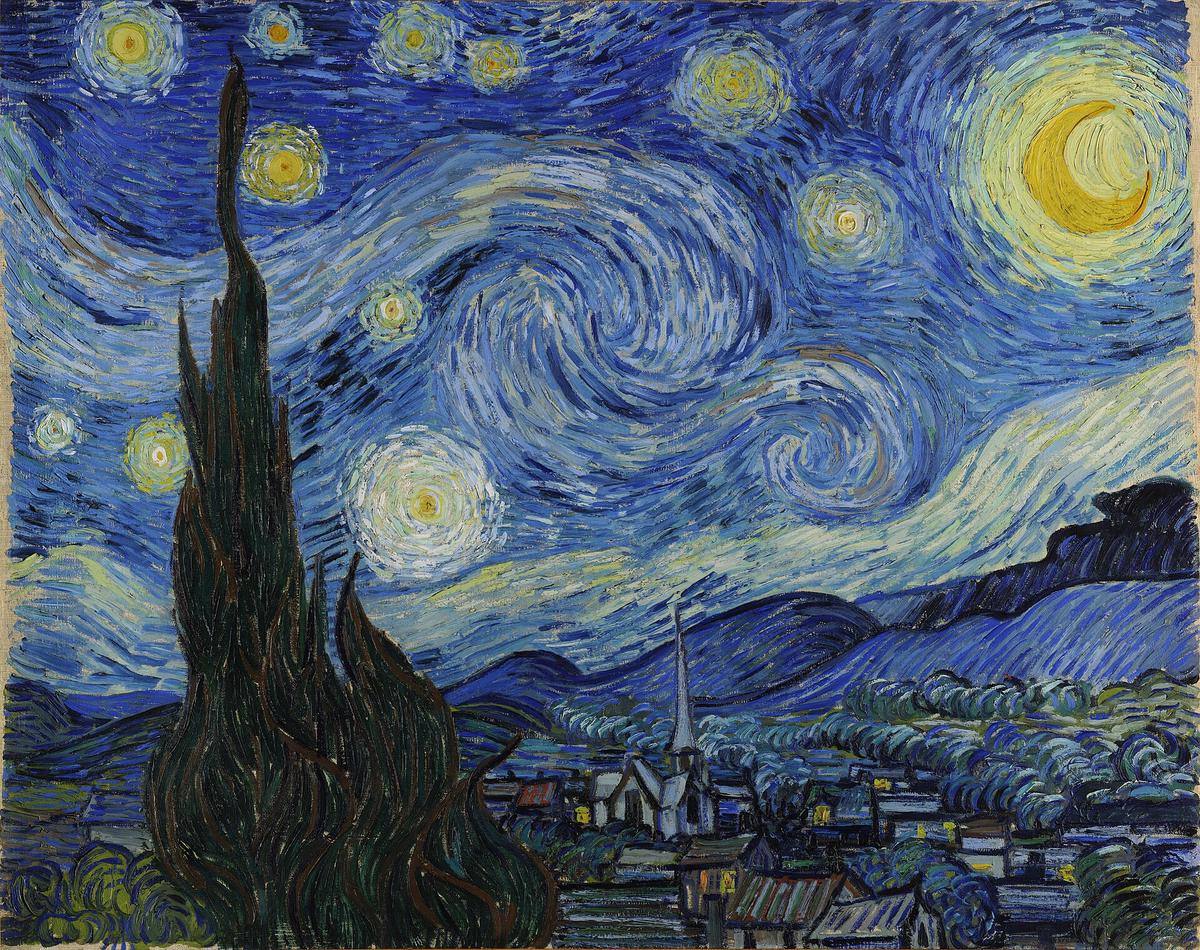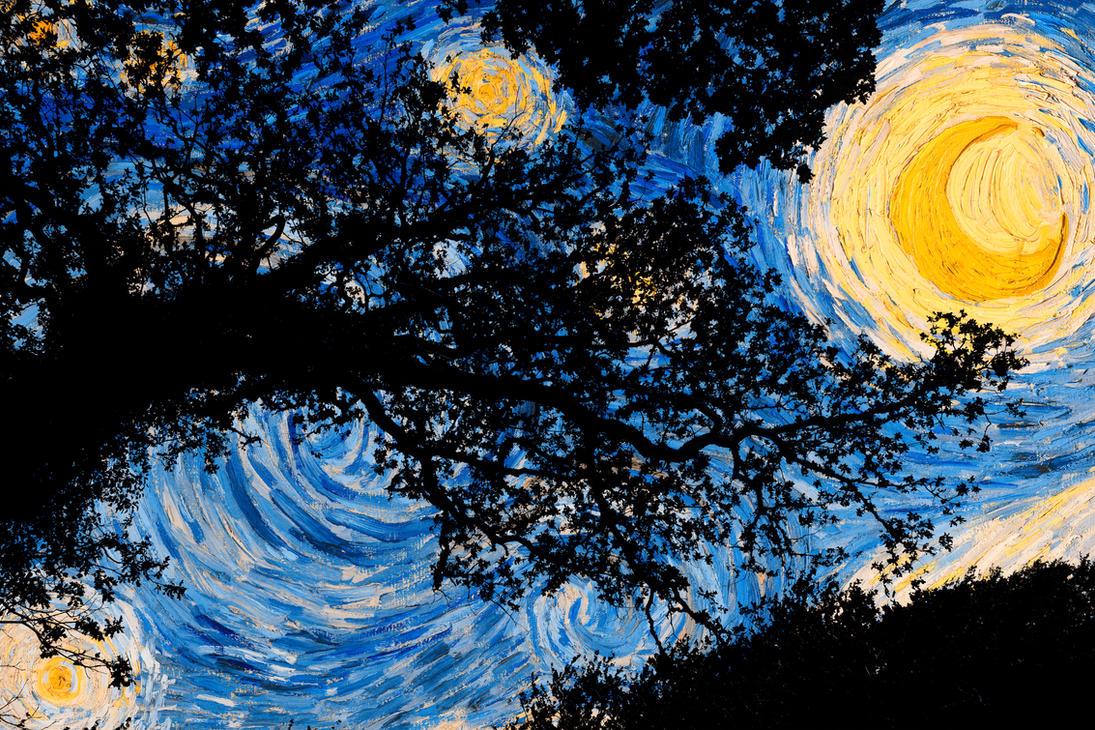Historical Fascination with the Night Sky
Vincent van Gogh's "Starry Night" (1889) is a key post-impressionist work, contrasting a swirling night sky with a serene village below. Its thick strokes suggest cosmic motion, hinting at Van Gogh's inner turmoil.
Alma Thomas's "Starry Night and the Astronauts" (1972) captures space exploration through rhythmic paint dabs, reflecting the era's excitement about Apollo missions. Her work feels both organic and methodical, echoing space's vastness.
Georgia O'Keeffe's "Starlight Night" (1917) blends nature with abstraction, connecting earthly landscapes to the cosmos. Angela Bulloch's LED "Night Sky" installations simulate views from space, challenging our perspective of the galaxy.
Théodore Géricault's "After the Deluge" (1819) explores post-catastrophe worlds, blending human emotion with celestial phenomena. Wolfgang Tillmans captured the 2004 Venus transit, bridging astronomy and personal nostalgia.
Thomas Ruff's "Sterne" series showcases detailed cosmos photographs from the European Southern Observatory, often resembling cloudy skies. Zhao Zhao's "Constellations" series interprets trauma through abstract starbursts from shattered glass.
Betye Saar's "Celestial Universe" (1988) combines mythology and star maps on silk taffeta, infusing wonder into intricate cosmic artworks. Suki Chan's "Lucida II" (2017) explores vision loss, juxtaposing human fragility against the night sky's vastness.
Throughout history, the night sky has inspired awe and introspection. Artists continue to tap into its allure, transforming starlit imaginings into enduring visions.

Scientific and Artistic Intersections
Tim Reyes merges astronomical data with artistic abstraction, creating works inspired by the Planck Space Telescope's cosmic microwave background radiation images. This synergy between science and art allows for a deeper appreciation of the cosmos from multiple perspectives.
Angela Bulloch's 'Night Sky' series uses LED installations based on Celestia software, offering unique galactic viewpoints. These works echo the technological marvels of Planck data, blurring the line between art and science.
Historical intersections are evident in how Maxwell's equations influenced artists' perceptions of light and space. Van Gogh's swirling stars parallel Maxwell's electromagnetic wave theories, suggesting a cosmic dance in paint.
Zhao Zhao's 'Constellations' series uses shattered glass to illustrate cosmic events, blending personal trauma with universal phenomena. Suki Chan's 'Lucida II' explores visual perception through interdisciplinary collaboration, questioning our ability to interpret the night sky.
Betye Saar's 'Celestial Universe' (1988) interweaves star maps with mythology, transforming scientific tools into artistic expression. Trevor Paglen's 'Orbital Reflector' sparked debate about human-made versus natural celestial phenomena, highlighting our capacity to alter the cosmos.
These examples demonstrate how scientific breakthroughs inspire artistic works and vice versa, continually expanding our perception of the universe. The night sky becomes a dynamic canvas, alive with scientific inquiry and artistic imagination.

Modern Artistic Interpretations of Space
Angela Bulloch's "Night Sky" series uses LED installations to create celestial views beyond Earth's perspective. Based on Celestia software, her work invites viewers to experience the universe from new vantage points, challenging our place in the cosmos.
Wolfgang Tillmans captured the 2004 Venus transit, blending personal nostalgia with astronomical precision. His images highlight the vastness of space and our place within it.
Betye Saar's "Celestial Universe" (1988) merges art, mythology, and personal history on silk taffeta. Her intricate star maps and zodiac symbols invite viewers to consider the mystical connections between humans and the cosmos.
Zhao Zhao's "Constellations" series transforms shattered glass into cosmic starbursts, drawing parallels between human trauma and dramatic celestial events. This work blurs the lines between personal pain and the beauty of the stars.
Suki Chan's "Lucida II" (2017) explores human perception of space through stories of vision loss, juxtaposing human sight limitations with the potential of telescopic and digital vision.
Trevor Paglen's "Orbital Reflector" placed a man-made object into orbit, visible from Earth. This project sparked dialogue on the ethics of altering the night sky and our relationship with space.1
Impact of Modern Space Art:
- Challenges traditional perspectives of the cosmos
- Incorporates cutting-edge technology in artistic expression
- Explores the intersection of personal experience and universal phenomena
- Raises ethical questions about human interaction with space
These modern interpretations go beyond representation, using technology and personal experience to create immersive works. They challenge our understanding of reality and invite reflection on our place in the universe, transforming the cosmos into a canvas for human imagination and philosophy.
Artistic Techniques and Mediums
Artists use a variety of techniques and mediums to depict the cosmos, from traditional painting to modern digital art. These approaches expand our visual understanding and deepen our connection to the universe.
Thomas Ruff's "Sterne" series uses high-resolution photographs from the European Southern Observatory, transforming them into large-scale prints that reveal celestial details invisible to the naked eye. His work blends scientific technology with artistic interpretation, creating ethereal celestial portraits.
Zhao Zhao's "Constellations" series takes a more visceral approach. By shooting into glass panes and interpreting the patterns through oil paint and silk embroidery, Zhao creates a dynamic tension between destruction and creation, mirroring cosmic processes. The embroidery adds cultural significance to the stark starburst patterns.
Alma Thomas's "Starry Night and the Astronauts" uses acrylic paint to build mosaic-like fields of color, evoking the luminosity of space. Her vibrant, textured surfaces reflect the optimism of the space age while honoring traditional painting techniques.
Betye Saar's "Celestial Universe" incorporates silk taffeta as a canvas, using hand-painted techniques to map stars and constellations. The shimmering effect mimics twinkling stars, transforming the fabric into a celestial map that invites viewers to ponder the myths woven into the night sky.
Suki Chan's "Lucida II" uses film to explore human vision, capturing the night sky through a lens that highlights emotional and cognitive aspects of sight. Chan combines traditional filming techniques with modern digital enhancements to create an immersive experience.
Angela Bulloch's LED light installations represent the cutting edge of cosmic art. Using digital software to simulate celestial views, Bulloch creates dynamic, shifting representations of the night sky that change in real-time, challenging traditional notions of static art.
These varied approaches reflect the multifaceted nature of cosmic art, offering unique lenses through which to explore the infinite. From tangible textures to digital precision, each method pushes us to reimagine the stars and our connection to them.

The Role of Technology in Cosmic Art
Technology has significantly influenced cosmic art, adding new layers of depth and nuance to contemporary pieces. It allows artists and audiences to explore perspectives of the universe beyond our daily experiences.
Trevor Paglen's 'Orbital Reflector' project exemplifies the fusion of art and space technology. This reflective sculpture, launched into orbit, transcends traditional art installations by existing as a man-made celestial body. Paglen's work sparks dialogue about human capabilities and the reach of art beyond Earth.
Suki Chan's film "Lucida II" uses technology to examine human perception of the night sky. By integrating scientific expertise with cinematic techniques, Chan creates a multidimensional account that explores the emotional and cognitive aspects of sight. This collaboration with scientists broadens the scope of her artistic inquiry and offers viewers a richer experience.
Angela Bulloch's "Night Sky" series uses LED installations and computer simulations to construct dynamic celestial views. By using software tools like Celestia, originally designed for simulating space travel, she creates scenes that are both scientifically accurate and artistically inspired. Her installations challenge viewers to reimagine their position in the cosmos.
Technology often becomes a silent collaborator in cosmic art. Artists use computational algorithms to simulate astronomical phenomena, mirroring the precision of celestial mechanics. These digital orchestrations offer an educational glimpse at the cosmic order, making the wonders of the universe more accessible.
Space missions provide artists with unprecedented access to data and imagery. For example, the ESA's Planck Space Telescope offers high-resolution images of cosmic microwave background radiation. Artists like Tim Reyes merge these scientific snapshots with traditional artistic techniques, creating compositions that blend scientific inquiry with creative imagination.
Modern cosmic art benefits from advancements in:
- Solid-state electronics
- Infrared astronomy
- Radio wave imaging
This confluence of art and technology allows artists to craft nuanced depictions of the cosmos that resonate with contemporary audiences.
Wolfgang Tillmans' work highlights the integration of old and new technologies. Using a telescope from his youth enhanced with contemporary techniques, Tillmans documents celestial events like the transit of Venus, encapsulating the historical continuity and technological progression in modern cosmic art.
The fusion of art and technology in cosmic art offers new perspectives on the universe, inviting exploration, contemplation, and wonder.
Through these technologically infused works, the cosmos becomes a shared canvas, reflecting the boundless nature of the universe itself.
The night sky continues to inspire, prompting reflection on our place in the universe. Through art and technology, we uncover new perspectives, enriching our understanding and appreciation of the cosmos.























